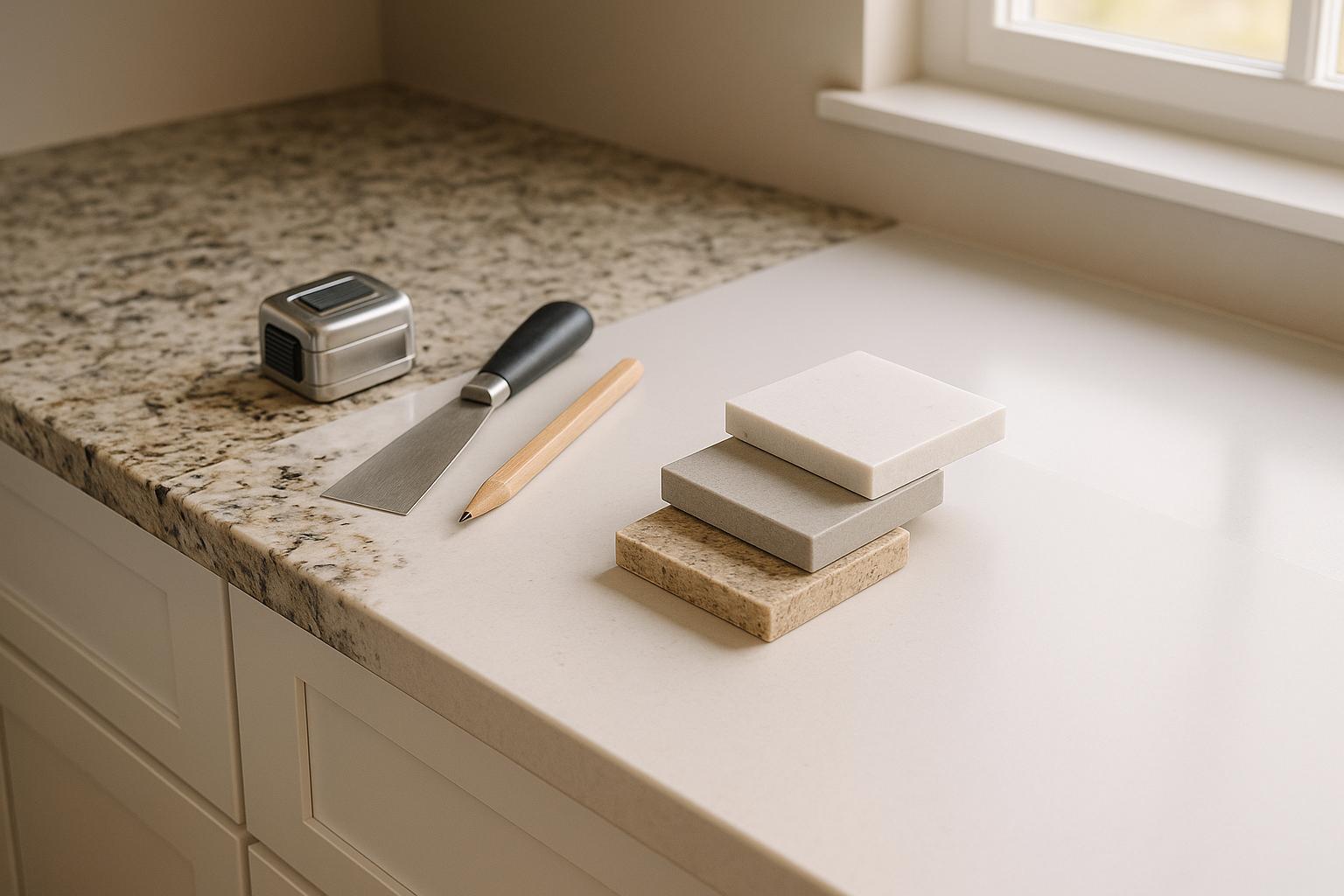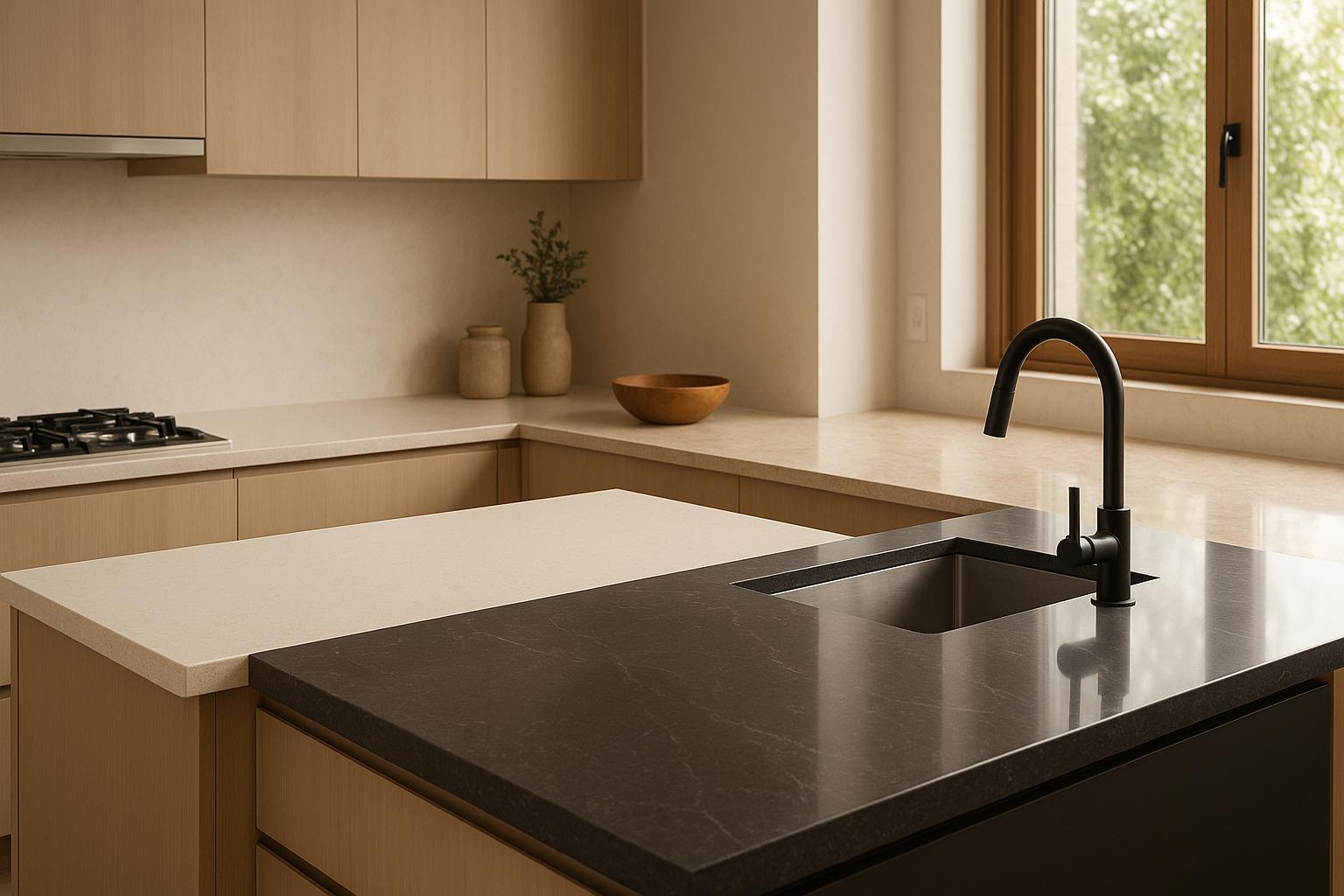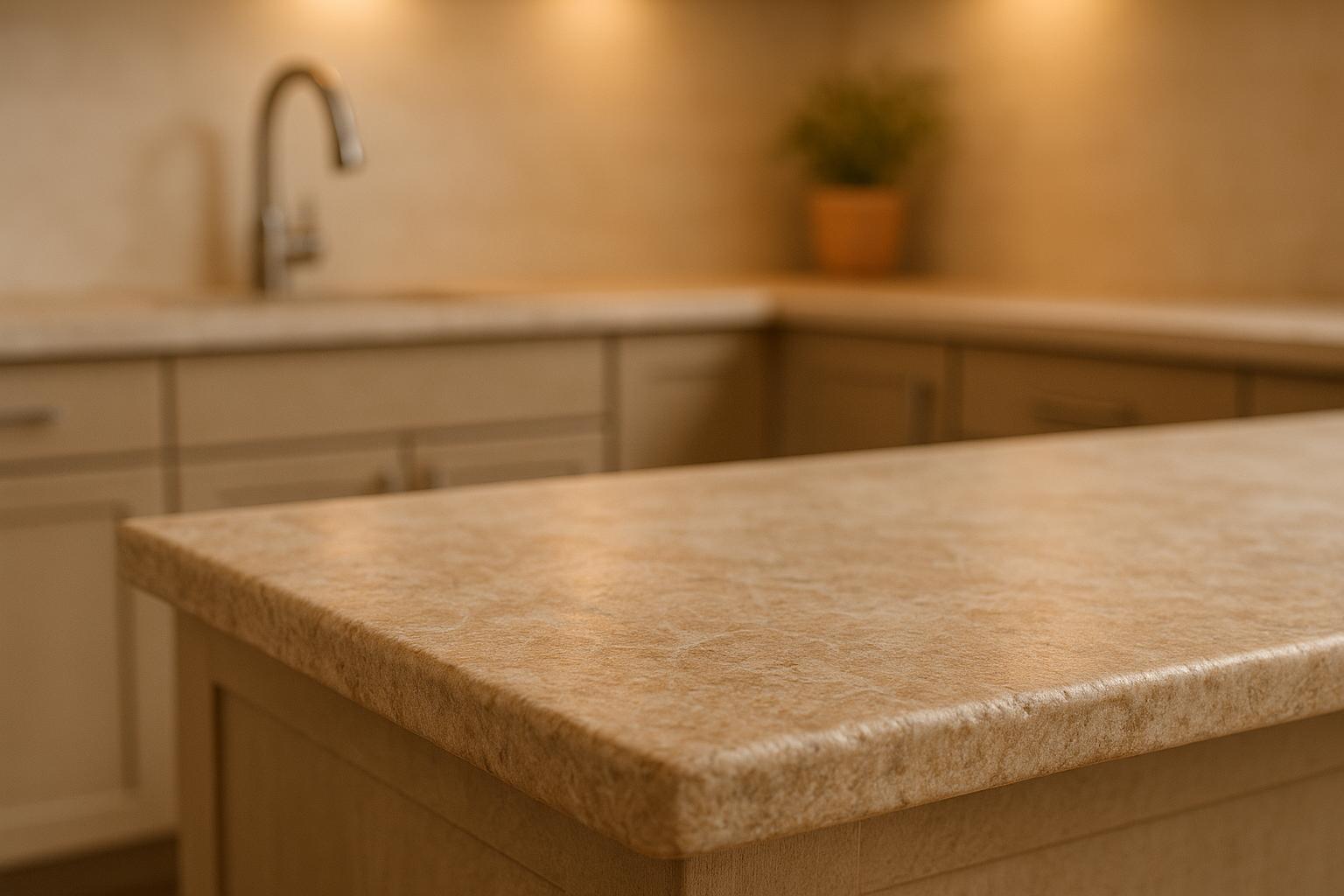When planning a countertop project, the total cost goes beyond just the material. Key expenses include material costs, labor, installation, and potential hidden fees like plumbing adjustments, sink cutouts, or cabinet reinforcements. Factors like your location, project size, and material choice (e.g., quartz, granite, or marble) heavily influence pricing.
Key Takeaways:
- Material Costs: Laminate is affordable, while marble and granite are more expensive.
- Labor Costs: Complex layouts increase labor fees.
- Hidden Costs: Permits, disposal fees, and structural changes can add up.
- Regional Differences: Urban areas often have higher costs due to labor rates and material transport.
Hiring professionals ensures precision and often includes warranties, but DIY can save money for simpler projects. Understanding these factors helps you budget effectively and avoid surprises.
The Hidden Factors of Kitchen Countertop Prices
Main Countertop Project Costs
Understanding the main costs involved in a countertop project can help you plan your budget more effectively. The key expenses to consider include materials, labor and installation, and regional price variations. Let’s break these down further.
Material Costs by Type
The type of material you choose plays a big role in the overall cost. Premium natural stones like quartz, granite, marble, and onyx are known for their striking appearance and durability, but they come with a higher price tag. On the other hand, porcelain offers a similar aesthetic appeal at a more affordable price. When deciding on a material, it’s important to weigh your design preferences against the long-term value it can provide.
Labor and Installation Costs
Labor and installation expenses depend heavily on the complexity of your design and the material you’ve selected. Simpler layouts tend to be more affordable, while custom designs or intricate patterns often require specialized skills, which can drive up the cost.
Regional Price Differences
Where you live can significantly impact both material and labor costs. Urban areas, for example, often have higher prices compared to suburban or rural locations due to elevated labor rates and material supply costs. Additionally, local market trends and the popularity of certain styles in your area can influence pricing. To get a clear picture, it’s always a good idea to request estimates from local professionals.
Hidden Costs to Watch Out For
Countertop projects can sometimes come with unexpected expenses, especially if the work involves structural adjustments, electrical updates, or plumbing changes. Being aware of these potential costs can help you plan your budget more effectively.
Permits and Warranties
If you’re simply replacing countertops, you likely won’t need a permit. However, if your project involves structural alterations, adding new wiring, significant plumbing work, or moving fixtures, permits may be required. It’s a good idea to check with your local authorities to understand the specific requirements and any fees involved.
When it comes to warranties, many manufacturers offer extensive coverage. Before purchasing an extended plan, take the time to review the included warranty to ensure you’re not paying for duplicate protection.
Budgeting Tips and Ways to Save Money
Careful planning is key to keeping costs under control and avoiding unexpected expenses. A well-thought-out approach ensures smarter financial decisions throughout your project.
Planning Your Project Scope
- Rely on professional services: Hiring experts for accurate measurements and custom templates ensures everything fits perfectly, saving you from costly mistakes.
- Request a free quote early: Getting an estimate upfront helps you understand the costs involved and set a budget that’s realistic and achievable.
sbb-itb-e397dd0
Countertop Materials and Installation Methods Compared
When it comes to countertops, your choice of materials and installation methods can significantly impact both your budget and the durability of the finished product. Let’s break down the options to help you make an informed decision.
Material Comparison Table
Different countertop materials bring unique qualities to the table. Here’s a quick look at how they compare in terms of durability, maintenance, heat resistance, and overall appearance:
| Material | Durability | Maintenance | Heat Resistance | Appearance |
|---|---|---|---|---|
| Quartz | Highly durable – non-porous and scratch-resistant | Low – simple cleaning with soap and water | Good (use heat pads to avoid damage) | Consistent patterns with a wide range of colors |
| Granite | Extremely tough – resists chipping | Moderate – needs periodic sealing | Excellent – handles high heat well | Unique natural patterns with earthy tones |
| Marble | Durable but softer – prone to etching | High – requires sealing and careful upkeep | Fair – sensitive to heat exposure | Timeless elegance with natural veining |
| Onyx | Moderately durable – requires gentle care | High – frequent sealing needed | Poor – very heat-sensitive | Dramatic, translucent veining for bold designs |
| Porcelain | Exceptionally hard – stain-resistant | Very low – nearly maintenance-free | Excellent – resists high heat | Sleek, uniform look that mimics natural stone |
Key takeaways:
- Quartz strikes a great balance between durability and low maintenance.
- Granite is ideal for high-heat areas, thanks to its natural toughness.
- Porcelain is a go-to choice for busy kitchens, offering durability and minimal upkeep.
DIY vs. Professional Installation Comparison
Your approach to installation – whether you tackle it yourself or hire professionals – can make a big difference in cost, time, and quality. Here’s how the two options stack up:
| Factor | DIY Installation | Professional Installation |
|---|---|---|
| Labor Cost | Low monetary cost but high time investment | Includes labor fees for skilled workmanship |
| Tool Investment | Requires buying or renting specialized tools | Tools are provided as part of the service |
| Project Timeline | Can take several weekends to complete | Typically finished in a shorter timeframe |
| Warranty Coverage | Covers materials only – no warranty on labor | Often includes a warranty for materials and labor |
| Risk and Complexity | High – errors are more likely with intricate designs | Low – handled by experts with precision |
What to consider:
- DIY works well for straightforward projects and smaller budgets, but it requires time, tools, and a steady hand.
- Professional installation is worth the investment for complex designs or expensive materials, offering peace of mind with warranties and expert precision.
Why Choose MI Stone for Your Countertop Project

When it comes to creating your dream countertop, picking the right partner can make all the difference. MI Stone combines expertise, comprehensive services, and transparent pricing to deliver both quality and value. With them, you can expect stunning results without unpleasant surprises along the way.
Expertise in High-Quality Natural Stone
MI Stone is all about premium natural stone. Their collection features a wide variety of tiles and slabs sourced from around the world, offering patterns and colors that go far beyond the ordinary.
Whether you’re drawn to the sleek consistency of quartz, the dramatic veining of marble, or the eye-catching translucency of onyx, MI Stone has options to match your style and budget. Their team’s knowledge ensures you’ll find the perfect balance between beauty and durability for your project.
Complete Services
MI Stone takes care of everything, offering a one-stop solution for your countertop needs. Their skilled fabrication and installation team handles every detail – from precise measurements to the final touches – ensuring a flawless fit, even for tricky layouts.
If you’re planning a full kitchen remodel, MI Stone goes a step further with cabinetry options. This streamlined approach ensures that every part of your kitchen design works together seamlessly, saving you time and effort.
Clear Pricing and No Hidden Costs
No one likes surprise expenses, especially during a home improvement project. MI Stone eliminates this headache with straightforward pricing and detailed estimates provided right from the start. Their initial consultation lays out all costs clearly, helping you stay on budget and on schedule without any guesswork.
Conclusion: Key Points to Remember
As you wrap up your planning, it’s important to keep a few cost considerations front and center. A successful countertop project isn’t just about picking the perfect material – it’s also about being prepared for both the obvious and less obvious expenses that can influence your final budget.
Hidden costs, like demolition, electrical work, or permits, can sneak up on you and inflate your total spend. To avoid surprises, always ask for detailed estimates that clearly break down all cost components.
Opting for professional installation ensures precision through the use of specialized tools and high-quality materials. Plus, the warranties that often come with professional services provide added peace of mind, covering both fabrication and installation issues.
Investing in quality materials and skilled craftsmanship may feel like a bigger upfront expense, but it often saves you from costly repairs or replacements down the road.
Lastly, regional pricing differences can play a role in your project’s cost. This makes it even more important to work with experienced professionals who provide clear and transparent pricing. With these insights in hand, you’re well-equipped to bring your countertop vision to life.
FAQs
What hidden costs should I consider before starting a countertop project?
When you’re planning a countertop project, it’s crucial to consider potential hidden costs that could impact your budget. For example, you might need to cover the removal and disposal of old countertops, which can range from $50 to $300. If you’re opting for heavier materials like granite or quartz, you may also need to invest in additional structural supports. On top of that, plumbing or electrical adjustments might be necessary to fit the new setup.
There’s also the chance of encountering unexpected repairs. Issues like moisture damage from poor sealing or uneven surfaces could crop up during installation. By accounting for these possibilities from the start, you can minimize surprises and keep your project running smoothly.
How do location and regional factors influence countertop project costs, and how can I reduce their impact?
Regional factors play a big role in determining the cost of countertop projects. Things like local labor rates, transportation expenses, and material availability can all impact your budget. For example, if you’re in an area with higher wages or limited access to specific materials, you might face steeper costs.
To keep expenses in check, try sourcing materials that are readily available in your area – this can cut down on shipping fees. Partnering with a reliable local provider and having an open conversation about your budget early on can also uncover more affordable options. Choosing durable yet budget-friendly materials, such as engineered quartz or porcelain, is another way to balance cost with quality and style.
Is it cheaper to install countertops yourself, or should you hire a professional?
Taking the DIY route for countertop installation might seem like a way to save money at first glance. However, it comes with its fair share of risks – think measurement mistakes, improper fitting, or even accidental damage to the materials. These errors can quickly add up, leading to extra costs for repairs or replacements that might end up costing more than hiring a professional in the first place.
Bringing in professionals, on the other hand, offers several advantages. They provide precise measurements, expert-level installation, and often include warranties that give you peace of mind. This approach can save you time, reduce stress, and help you avoid expensive mishaps. If you’re aiming for a reliable, polished finish, professional installation typically proves to be the smarter investment.



